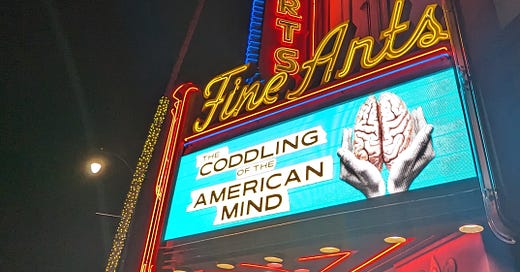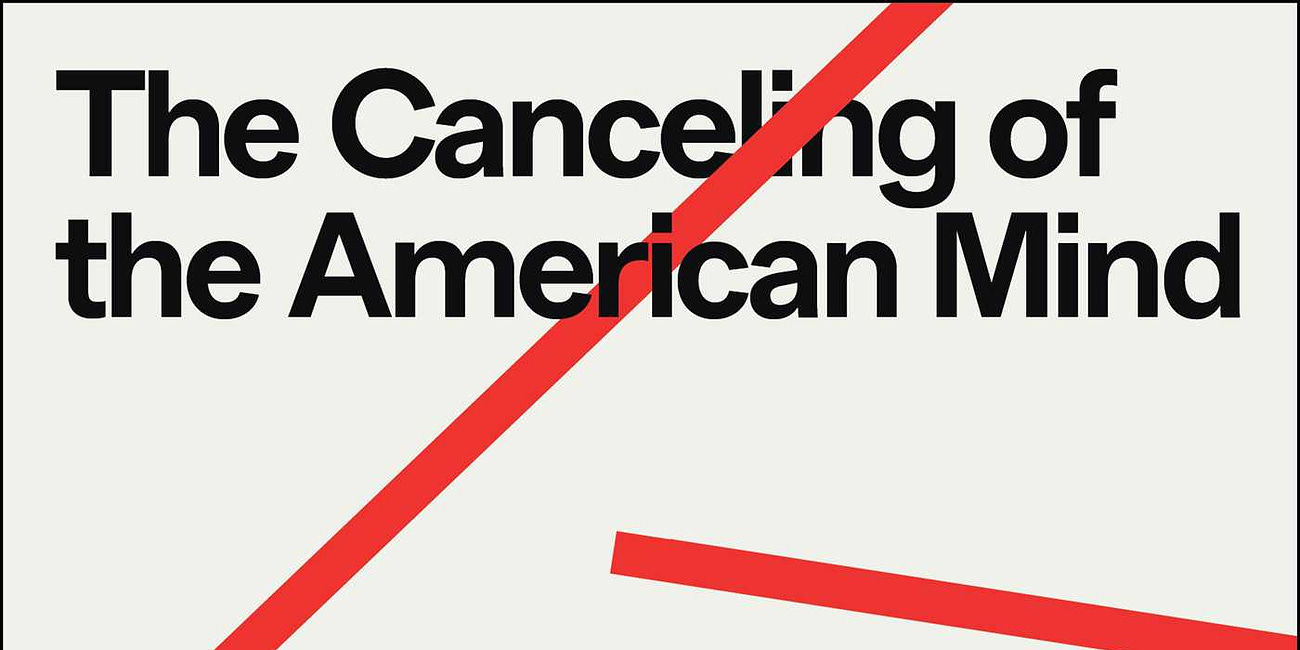Weekend reads: 'I'm stronger than I was told'
A Q&A with Ted Balaker, director of The Coddling of the American Mind
When Greg Lukianoff and Jonathan Haidt published their blockbuster article in The Atlantic in 2015, raising the alarm on a mental health crisis emerging on campuses across the country, they were ahead of their time. Now, with the explosion of coverage on Gen Z’s epidemic of anxiety, their work is more relevant than ever.
So, the timing is good for a new film based on the pair’s New York Times bestselling book, The Coddling of the American Mind. The movie of the same name, which can be streamed on Substack, is currently touring America. Lean Out caught up with director Ted Balaker to talk about young people, anxiety, ideology — and the power of embracing anti-fragility.
TH: The Gen Z mental health crisis has become a huge topic in recent months. Jonathan Haidt and Greg Lukianoff, with their Atlantic essay and subsequent book, The Coddling of the American Mind, were among the first to raise the alarm on this phenomenon. To start today, can you talk about that book — and what drew you to it?
TB: In The Coddling of the American Mind, Greg Lukianoff and Jonathan Haidt embarked on a social science mystery, trying to figure out why this generation was so anxious and depressed. They came up with a number of very interesting ideas. Three of them — the Three Great Untruths — we cover in the movie. We shortened the names for the purposes of the movie. The first Great Untruth is “you are fragile.” The second Great Untruth is “always trust your feelings.” The third Great Untruth is “us versus them,” seeing the world as a struggle between good people and evil people.
Greg and Jon said that if you believe these three Great Untruths — which are, as they point out, wrong not just according to ancient wisdom, but also modern psychology — you will almost certainly be miserable. What we explore in our movie is a global group of twentysomethings. Each had their own experiences with these untruths. They are part of this anxious generation and are searching for happiness.
TH: The young people in the film are pretty remarkable. Tell us about Aryaan, who was effectively cancelled at university for taking a stand against this ethos.
TB: Aryaan is an international student from India. He grew up in some fairly hard circumstances and came to Michigan for college. He stood up against a DEI program and other things that he was forced to do as a condition of being an employee at the college. Although he had a scholarship, in order to pay for books and things like that he really needed extra money. He comes from pretty modest means. And so, he had three jobs at the university. At least two of them, as I recall, required him to take a DEI training. He objected to it on free speech grounds. He wrote an email that he sent to administrators.
Then he ended up posting the email on Twitter. That’s when he got a big blowback from students and others. People who are familiar with the heartbreaking things that happen fairly often on campus these days won’t be surprised to hear that he lost friends and was isolated on campus. All this happened because he stood up for his principles. He was a target of very open hostility, online and elsewhere. But then, behind the scenes, in DMs and direct emails, people would support him. This is a pattern that we see a lot in other facets of cancel culture: public scorn and private support. As Aryaan says in the movie, he was expecting Twitter to be insane, because that’s what Twitter does. But the fact that people who supported him only did it privately — that’s what really hurt. This is professors, other students, and so on. They were moved enough to reach out to him, but not courageous enough to do it publicly.
TH: You also profile Lucy, a young woman who went to Stanford from a hospital psych ward. What did you take away from her story?
TB: Lucy is fantastic. When she entered Stanford as a freshman, she was only months removed from being in a psych ward. You might look at that and say, “She was already in a bad position.” But she had really turned her life around … So, she started off on the right foot, but then quickly fell into the social justice spiral through disability activism. She’s autistic … Through that lens, she learned a lot of things. Number one: She found that the Stanford administrators expected less from their students than the psych hospitals expected from patients ...
Her story is multi-layered, like the others’ stories are. And one very important layer is that if you are someone who is autistic or has similar conditions, it’s very difficult to navigate the landmines of the modern university, because autistic people have a hard time picking up on social cues. If you’re in a situation where if you say the wrong thing, or do the wrong thing, or use the wrong phrase, you could be socially ostracized or worse — that’s a perilous place to be in.
Lucy talks about how autistic people are way more likely to get caught in the crosshairs, simply because these rules are always evolving, and difficult to understand, even if you don’t have autism. So having a condition like that just makes it all the more difficult. Which is ironic, because a lot of these policies are put in place ostensibly for students like Lucy, who have disabilities.
TH: You worked on this film for years. You have thought about all of this deeply. What conclusions have you come to about this ideology, and how it gained purchase?
TB: It’s an important question … [I think] the groups of students who are supposedly being helped the most are actually oftentimes being hurt the most by these programs … It’s not like they underwent rigorous testing to make sure that they were safe and effective.
[For instance] the start to microaggression training happened with a 2007 article written by a professor at Columbia University. It really only took, by my estimation, probably six or so years for this idea of microaggression training to go from being an obscure academic term to being ubiquitous on college campuses. And then not too long afterwards, the culture at large. You have a lot of teenagers today who talk like sociology TAs; they’re using this academic jargon. It’s quite bizarre, because academia churns out something like one million peer-reviewed articles each year, and most of them are read by almost nobody.
It’s a very interesting, sobering story, how this concept went from academic obscurity to ubiquity. If you are implementing these things at such a large scale with young, impressionable people — teenagers, most of them — you would think you would want to make sure that you have a lot of evidence. In 2017, a professor of psychology named Scott Lilienfeld basically sounded the alarm and said, “We need a moratorium on microaggression training. The claims are not backed by evidence, and it has lots of potential harms.” Of course, he was basically ignored by most universities, because now it has solidified into dogma. And be careful if you are bold enough to criticize it!
The tragedy behind this is that these trainings are done supposedly to help people, but it turns them into miserable people. They are paranoid, they are anxious, they become depressed. Why wouldn’t you be — if you think everybody hates you? … It’s easy to see why, if you think everybody is out to hurt you, that just really wrecks your ability to function as a normal human being.
TH: You’re on tour with the film right now, and you were just at Harvard. What’s the response been like on the ground?
TB: I’m happy to say that so far the response has been really outstanding. We’re collecting responses from students who tell us things like they see themselves in our interview subjects. We have young people telling us things like, “I’m stronger than I was told.” Amna Khalid, a professor at Carleton College, which hosted two screenings, emailed me and said that the film helped her students talk about a lot of things that they hadn’t been able to talk about. Words like that are more precious than gold to us. The fact that so many students are reacting that way is very heartening.
But it’s funny, we also get [feedback] that students realize our film is a very unusual perspective. It’s not one that they’re used to hearing. And so, they realize that it is a dangerous film in many ways … There was a young woman at UCLA who came up to me after a screening, and she described herself as being very progressive and said that she saw herself in our interview subjects. She said she also used to exhibit those harmful thought patterns, but she was able to apparently get out of it. She was very kind about the film and very complimentary of it. I asked, “Would you mind taking a photograph with me, because we like to document [the tour]?” She very politely declined. It was pretty clear to me that it was because it wouldn’t be a good idea for her to be seen with someone like me, who made a movie like this.
Even though she had escaped that worldview, it sounded like at least part of it still had a grip on her. And you can understand that. Because when you’re in your teens and away from home, your friends and your social network are especially important. And it can be very dangerous these days to hold the wrong opinion.
This interview has been edited and condensed.
For more on this topic, check out my recent podcast interview with Greg Lukianoff.






Thanks for sharing this Tara - I am going to rent the film and watch it with my family.